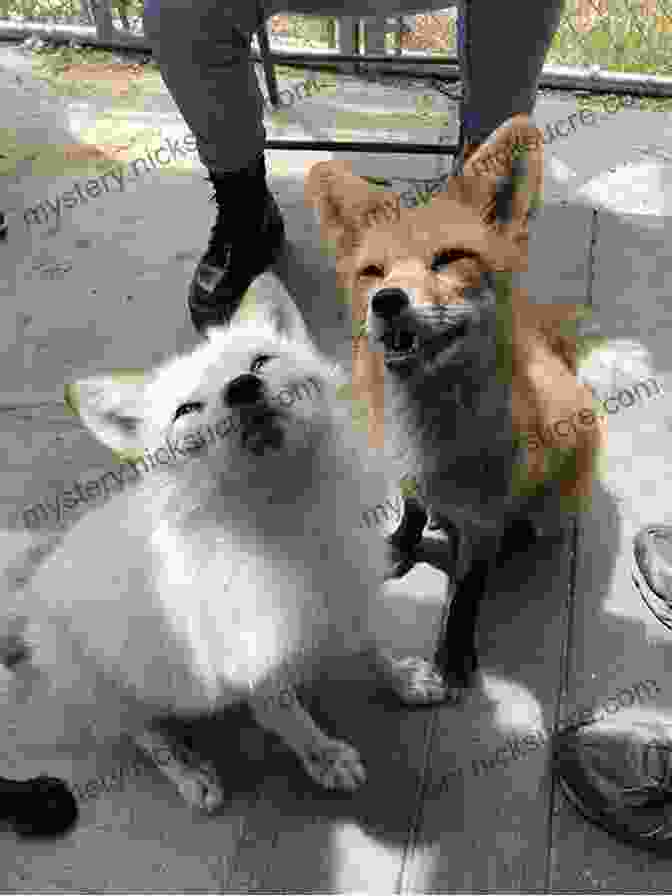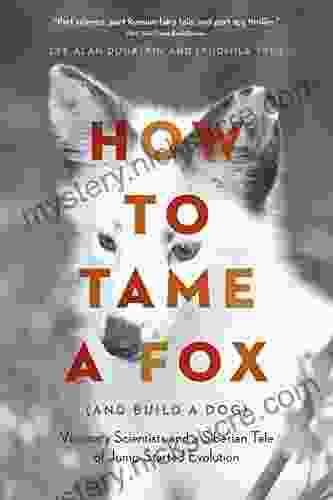Taming the Wild: A Comprehensive Guide to Domesticating Foxes and Creating Canine Companions


Throughout history, humans have shared an enduring fascination with the enigmatic creatures known as foxes. These cunning and captivating animals have long captivated our imaginations, inspiring folklore, fables, and countless works of art. While traditionally perceived as untamable, recent advancements in animal behavior research have opened up the possibility of domesticating foxes, offering unprecedented insights into interspecies relationships and challenging long-held beliefs about animal companionship.
4.7 out of 5
| Language | : | English |
| File size | : | 13364 KB |
| Text-to-Speech | : | Enabled |
| Screen Reader | : | Supported |
| Enhanced typesetting | : | Enabled |
| Word Wise | : | Enabled |
| Print length | : | 236 pages |
| Lending | : | Enabled |
This comprehensive guide delves into the fascinating world of fox domestication, providing a detailed roadmap for aspiring fox owners on how to successfully tame and raise these remarkable animals as cherished canine companions. From understanding their unique biology and behavior to providing them with essential care and training, we will explore every aspect of this extraordinary endeavor, empowering you to create a harmonious and fulfilling bond with your very own tamed fox.
Understanding the Fox's Natural Instincts
Before embarking on the journey of domesticating a fox, it is crucial to gain a comprehensive understanding of their inherent nature and behavior. Foxes belong to the genus _Vulpes_, a group of highly adaptable and intelligent canids that have thrived in diverse habitats around the world. Their keen senses, exceptional agility, and opportunistic hunting strategies have enabled them to survive in a wide range of environments, from dense forests to open grasslands.
Domesticated foxes share many similarities with their wild counterparts, retaining certain instincts that have evolved over millennia. Understanding these instincts is essential for providing appropriate care and fostering a healthy relationship with your tamed fox. Here are some key characteristics:
- Nocturnal Behavior: Foxes are primarily nocturnal animals, meaning they are most active during the night. This natural rhythm should be taken into consideration when planning their feeding schedules and providing them with a suitable sleeping environment.
- Social Hierarchies: Foxes live in social groups with a well-defined hierarchy. Establishing a clear dominance relationship with your fox is essential for maintaining order and preventing behavioral issues.
- Territorial and Alert: Foxes are territorial animals that instinctively defend their home range from potential threats. They are also highly alert and may react defensively if they perceive a perceived danger.
- Natural Predators: While domesticated foxes are no longer subject to the same predators as their wild brethren, they retain a natural fear of larger animals such as wolves and bears. It is important to provide them with a safe and secure environment that minimizes exposure to such potential threats.
Selecting and Acquiring a Fox
The first step towards domesticating a fox is to select and acquire a suitable individual. While it may be tempting to adopt a wild fox, it is strongly discouraged due to the inherent risks and challenges involved. Wild foxes are not accustomed to human interaction and may carry diseases that can be dangerous to both humans and other domesticated animals.
Instead, it is highly recommended to obtain a fox from a reputable breeder who specializes in domestication. These breeders carefully select and breed foxes with desirable temperaments and characteristics, ensuring a higher probability of successful domestication. When choosing a fox, it is important to consider the following factors:
- Age: Foxes are most receptive to domestication during their early developmental stages. Ideally, you should acquire a fox that is between 4 and 12 weeks old.
- Temperament: Observe the fox's behavior and interactions to assess its personality and temperament. Look for a fox that is friendly, curious, and exhibits good socialization skills.
- Health: Request health records from the breeder and ensure that the fox has received appropriate vaccinations and veterinary care.
Creating a Suitable Habitat
Providing a safe and comfortable habitat is essential for the well-being of your domesticated fox. The ideal enclosure should mimic their natural environment as closely as possible, offering ample space for movement, exploration, and sensory enrichment. Here are the key considerations:
- Size: The enclosure should be large enough to provide the fox with adequate space to move around, play, and engage in natural behaviors.
- Security: The enclosure must be escape-proof and secure from potential predators. Ensure that all fencing and mesh are robust and high enough to prevent the fox from climbing over.
- Shelter: Provide your fox with a sheltered area within the enclosure that offers protection from the elements, such as a den or a weather-resistant shelter.
- Enrichment: Foxes are naturally curious and playful animals. To prevent boredom and stimulate their cognitive and physical development, provide them with a variety of enrichment items such as toys, puzzles, and interactive feeders.
Essential Care and Nutrition
Like any domesticated animal, foxes require proper care and nutrition to thrive. Providing a balanced diet, maintaining a clean and healthy environment, and ensuring regular veterinary check-ups are crucial for their overall well-being.
- Diet: Domesticated foxes are omnivorous and require a diet that is rich in protein, fats, and essential vitamins and minerals. A combination of high-quality commercial dog food, supplemented with fresh meat, fruits, and vegetables, can provide a well-rounded nutritional foundation.
- Hygiene: Foxes are generally clean animals but may require occasional bathing. Use a gentle shampoo and avoid using excessive water or harsh chemicals that may irritate their skin. Regularly clean their enclosure and provide them with fresh water at all times.
- Veterinary Care: Establish a relationship with a veterinarian who is experienced in exotic animal care. Regular check-ups, vaccinations, and parasite prevention are essential for maintaining your fox's health and preventing potential medical issues.
Training and Socialization
Proper training and socialization are fundamental for creating a harmonious bond with your domesticated fox. These processes should begin as early as possible and should be approached with patience, positive reinforcement, and consistency.
- Training: Start by teaching your fox basic commands such as "sit," "stay," and "come." Use treats or praise as rewards for desired behaviors and avoid punishment, as this can damage your relationship with the fox.
- Socialization: Exposing your fox to different environments, people, and animals is essential for developing their social skills and preventing fear or aggression. Supervise these interactions closely and intervene if necessary to prevent negative experiences.
Building a Bond
The domestication of a fox is an ongoing journey that requires commitment, patience, and a deep understanding of their unique needs. Building a genuine bond with your fox is a gradual process that involves mutual trust, affection, and shared experiences.
- Spending Time Together: Dedicate a significant amount of time to interacting with your fox. Engage in activities that they enjoy, such as playing, exploring, or cuddling. This quality time together will strengthen your bond and build trust.
- Understanding Body Language: Learn to recognize the different ways in which your fox communicates. By understanding their body language, you will be better equipped to meet their needs and respond appropriately to their emotional cues.
- Respecting Boundaries: Foxes, like all animals, need personal space and time to themselves. Respect their boundaries and do not force interaction upon them. Allow them to approach you on their terms and provide them with a quiet space where they can retreat if desired.
Challenges and Considerations
While the domestication of foxes can be a rewarding experience, it is important to acknowledge the potential challenges and considerations involved:
- Commitment: Domesticating a fox is a long-term commitment. Foxes can live for up to 10 years, requiring consistent care, attention, and financial resources throughout their lifetime.
- Legal Considerations: In some jurisdictions, there may be legal restrictions or regulations regarding the ownership of exotic animals. It is crucial to research local laws and obtain necessary permits before acquiring a fox.
- Unpredictability: Despite their domestication, foxes retain certain wild instincts and may exhibit unpredictable behaviors at times. It is important to be prepared for these moments and respond calmly to prevent negative consequences.
The domestication of foxes is a remarkable feat that showcases the incredible potential for interspecies relationships. By providing these enigmatic creatures with a loving home, appropriate care, and dedicated training, you can unlock their captivating personalities and forge a unique bond that defies traditional notions of animal companionship. May this guide empower you on your journey to understand, appreciate, and embrace the extraordinary beauty and companionship of a domesticated fox.
4.7 out of 5
| Language | : | English |
| File size | : | 13364 KB |
| Text-to-Speech | : | Enabled |
| Screen Reader | : | Supported |
| Enhanced typesetting | : | Enabled |
| Word Wise | : | Enabled |
| Print length | : | 236 pages |
| Lending | : | Enabled |
Do you want to contribute by writing guest posts on this blog?
Please contact us and send us a resume of previous articles that you have written.
 Fiction
Fiction Non Fiction
Non Fiction Romance
Romance Mystery
Mystery Thriller
Thriller SciFi
SciFi Fantasy
Fantasy Horror
Horror Biography
Biography Selfhelp
Selfhelp Business
Business History
History Classics
Classics Poetry
Poetry Childrens
Childrens Young Adult
Young Adult Educational
Educational Cooking
Cooking Travel
Travel Lifestyle
Lifestyle Spirituality
Spirituality Health
Health Fitness
Fitness Technology
Technology Science
Science Arts
Arts Crafts
Crafts DIY
DIY Gardening
Gardening Petcare
Petcare Luc Mehl
Luc Mehl Carrie Marie Bratley
Carrie Marie Bratley Roger Marshall
Roger Marshall Della Ata Khoury
Della Ata Khoury Chris Bonington
Chris Bonington Aaron Reed
Aaron Reed Wayne Coffey
Wayne Coffey Jim Wiese
Jim Wiese William Ellet
William Ellet Daniel Prince
Daniel Prince Leslie R Schover
Leslie R Schover Tim S Grover
Tim S Grover Norman Thelwell
Norman Thelwell Pam Flowers
Pam Flowers Diane Lindsey Reeves
Diane Lindsey Reeves Lingo Mastery
Lingo Mastery Cathy Glass
Cathy Glass Joanne Kimes
Joanne Kimes Douglas P Fry
Douglas P Fry Michelle Travis
Michelle Travis James Beard
James Beard John Kretschmer
John Kretschmer Steven W Dulan
Steven W Dulan Mona Bijjani
Mona Bijjani Kat Davis
Kat Davis Meghan Daum
Meghan Daum Jimmy Chin
Jimmy Chin Huberta Wiertsema
Huberta Wiertsema Keith Brewer
Keith Brewer Linda Rosenkrantz
Linda Rosenkrantz Donna Goldberg
Donna Goldberg Sheri Morehouse
Sheri Morehouse J Maarten Troost
J Maarten Troost W D Wetherell
W D Wetherell Stephen King
Stephen King Rand Cardwell
Rand Cardwell Michael A Tompkins
Michael A Tompkins Vivian Foster
Vivian Foster Nick Gamis
Nick Gamis David Tanis
David Tanis Scott Mactavish
Scott Mactavish Jeff Belanger
Jeff Belanger Creek Stewart
Creek Stewart Maha Alkurdi
Maha Alkurdi Declan Lyons
Declan Lyons Scarlett V Clark
Scarlett V Clark Sylvia Williams Dabney
Sylvia Williams Dabney Cassandra Mack
Cassandra Mack Dounya Awada
Dounya Awada William Rathje
William Rathje Bruce Van Brunt
Bruce Van Brunt Judith Merkle Riley
Judith Merkle Riley Sherri L Jackson
Sherri L Jackson Ivan Gridin
Ivan Gridin David Savedge
David Savedge Sue Elvis
Sue Elvis Mary C Townsend
Mary C Townsend Nedu
Nedu Collins Easy Learning
Collins Easy Learning Richard Bullivant
Richard Bullivant Jessica Howard
Jessica Howard Leah Zani
Leah Zani Susan Orlean
Susan Orlean Melanie Anne Phillips
Melanie Anne Phillips J R Rain
J R Rain Neville Goddard
Neville Goddard Nigel Cawthorne
Nigel Cawthorne Mark Stavish
Mark Stavish Philippe Karl
Philippe Karl Pedro Urvi
Pedro Urvi Scott Hartshorn
Scott Hartshorn Christine Mari Inzer
Christine Mari Inzer Tibor Rutar
Tibor Rutar Stella Cottrell
Stella Cottrell Sophie Messager
Sophie Messager Lisa Feldman Barrett
Lisa Feldman Barrett Rob Pate
Rob Pate George Daniel
George Daniel Ivy Hope
Ivy Hope Arrl Inc
Arrl Inc Jeff Scheetz
Jeff Scheetz Sophie D Coe
Sophie D Coe Tricia Levenseller
Tricia Levenseller Hugh Aldersey Williams
Hugh Aldersey Williams Melissa A Priblo Chapman
Melissa A Priblo Chapman Susan Frederick Gray
Susan Frederick Gray Peter Bodo
Peter Bodo Skip Lockwood
Skip Lockwood John Grehan
John Grehan Charles Staley
Charles Staley Chris Morton
Chris Morton Kathy Woods
Kathy Woods Jim Warnock
Jim Warnock Thomas Deetjen
Thomas Deetjen Ed Housewright
Ed Housewright Erin Macy
Erin Macy Emma Warren
Emma Warren Larry Larsen
Larry Larsen Fmg Publications Special Edition
Fmg Publications Special Edition James W Anderson
James W Anderson Veronica Eden
Veronica Eden David Wilber
David Wilber Martina D Antiochia
Martina D Antiochia Shaunti Feldhahn
Shaunti Feldhahn Paul Rabinow
Paul Rabinow Mark Stanton
Mark Stanton Elaine Tyler May
Elaine Tyler May Paige Powers
Paige Powers Sam Priestley
Sam Priestley Elizabeth May
Elizabeth May Mathew Orton
Mathew Orton Tanya Hackney
Tanya Hackney Oliver Sacks
Oliver Sacks Dr Monika Chopra
Dr Monika Chopra Matt Mullenix
Matt Mullenix Om Krishna Uprety
Om Krishna Uprety Katharine Mcgee
Katharine Mcgee Caitlyn Dare
Caitlyn Dare Trevelyan
Trevelyan Barbara Acello
Barbara Acello Clement Salvadori
Clement Salvadori Michael Tan
Michael Tan Malika Grayson
Malika Grayson Martina Mcbride
Martina Mcbride Samantha De Senna Fernandes
Samantha De Senna Fernandes Ron Rapoport
Ron Rapoport Thomas Carothers
Thomas Carothers Bruce Maxwell
Bruce Maxwell Jamie Marich
Jamie Marich Nikki Carroll
Nikki Carroll Dan Flores
Dan Flores Paul Murdin
Paul Murdin Maria Van Noord
Maria Van Noord Jack Canfield
Jack Canfield Carmen Davenport
Carmen Davenport E Ink Utilizer
E Ink Utilizer Joe Baker
Joe Baker James Goi Jr
James Goi Jr Graham Hancock
Graham Hancock Bryan Litz
Bryan Litz Cecil B Hartley
Cecil B Hartley James Miller
James Miller Eric P Lane
Eric P Lane Nicolas Bergeron
Nicolas Bergeron John J Ratey
John J Ratey Kaplan Test Prep
Kaplan Test Prep Sarah Prager
Sarah Prager Dick Hannula
Dick Hannula Mcgraw Hill
Mcgraw Hill Ned Feehally
Ned Feehally C F Crist
C F Crist Phil Bourque
Phil Bourque Robert Edward Grant
Robert Edward Grant Bruce Sutherland
Bruce Sutherland Henry Malone
Henry Malone Elena Paige
Elena Paige Julie Golob
Julie Golob Jane Brocket
Jane Brocket R L Medina
R L Medina Db King
Db King David Cannon
David Cannon Shawna Richer
Shawna Richer Tim Glover
Tim Glover Shelby Hailstone Law
Shelby Hailstone Law Celeste Headlee
Celeste Headlee Elmer Keith
Elmer Keith Francis Glebas
Francis Glebas Emily Lowry
Emily Lowry Tyler Trent
Tyler Trent Jill Angie
Jill Angie Tom Cunliffe
Tom Cunliffe Kevin Houston
Kevin Houston Winslow Tudor
Winslow Tudor Michael Lear Hynson
Michael Lear Hynson Anthony Camera
Anthony Camera R Scott Thornton
R Scott Thornton Gregory A Kompes
Gregory A Kompes L W Jacobs
L W Jacobs Leah Hazard
Leah Hazard Sheila A Sorrentino
Sheila A Sorrentino William Wood
William Wood Martin Davies
Martin Davies Jason Runkel Sperling
Jason Runkel Sperling Narain Moorjani
Narain Moorjani Scott Mcmillion
Scott Mcmillion David Eagleman
David Eagleman Suzanne Young
Suzanne Young Robert A Cutietta
Robert A Cutietta Buddy Levy
Buddy Levy Kendall Rose
Kendall Rose Mark Hansen
Mark Hansen Pat Rigsby
Pat Rigsby Niels H Lauersen
Niels H Lauersen Tim Freke
Tim Freke Greg W Prince
Greg W Prince Zachery Knowles
Zachery Knowles Carlos I Calle
Carlos I Calle Dave Bosanko
Dave Bosanko Nick Littlehales
Nick Littlehales John Vince
John Vince Issai Chozanshi
Issai Chozanshi Ian Leslie
Ian Leslie Cornelia Pelzer Elwood
Cornelia Pelzer Elwood Dina Nayeri
Dina Nayeri Healthfit Publishing
Healthfit Publishing Lynette Noni
Lynette Noni Jennifer Appel
Jennifer Appel Theodora Papatheodorou
Theodora Papatheodorou Dave Rearick
Dave Rearick Robert D Gibbons
Robert D Gibbons Roger J Davies
Roger J Davies John Burroughs
John Burroughs Sterling Test Prep
Sterling Test Prep Kevin A Morrison
Kevin A Morrison Byron L Reeder
Byron L Reeder Silvia Dunn
Silvia Dunn Richard Henry Dana
Richard Henry Dana Albert Rutherford
Albert Rutherford Valerie Poore
Valerie Poore Maren Stoffels
Maren Stoffels Jim West
Jim West Chris Pountney
Chris Pountney Julia Ann Clayton
Julia Ann Clayton Matthew Marchon
Matthew Marchon Peter J D Adamo
Peter J D Adamo Joseph Correa
Joseph Correa Terry Laughlin
Terry Laughlin Lisa Hopp
Lisa Hopp Leon Speroff
Leon Speroff Robert Larrison
Robert Larrison Laurie Notaro
Laurie Notaro William L Sullivan
William L Sullivan Rick Trickett
Rick Trickett Sarah Ockwell Smith
Sarah Ockwell Smith Victoria Honeybourne
Victoria Honeybourne Ian Tuhovsky
Ian Tuhovsky E W Barton Wright
E W Barton Wright Mo Gawdat
Mo Gawdat Thomas Achatz
Thomas Achatz Matthew Warner Osborn
Matthew Warner Osborn Douglas Preston
Douglas Preston Marc Bona
Marc Bona Guy Grieve
Guy Grieve Dianne Maroney
Dianne Maroney Pamela Weintraub
Pamela Weintraub Mike X Cohen
Mike X Cohen Paul A Offit
Paul A Offit Charles Salzberg
Charles Salzberg Michael Gurian
Michael Gurian Ashley Christensen
Ashley Christensen Phil Williams
Phil Williams Dan Romanchik Kb6nu
Dan Romanchik Kb6nu Sallyann Beresford
Sallyann Beresford Simon A Rego
Simon A Rego Warwick Deeping
Warwick Deeping Nawuth Keat
Nawuth Keat Tamara Ferguson
Tamara Ferguson Matt Price
Matt Price Wilhelm Reich
Wilhelm Reich Eric R Dodge
Eric R Dodge Helen Zuman
Helen Zuman C S Lewis
C S Lewis Jess J James
Jess J James Sarah Jacoby
Sarah Jacoby Carrie Hope Fletcher
Carrie Hope Fletcher Meg Cabot
Meg Cabot Stacey Rourke
Stacey Rourke Shea Ernshaw
Shea Ernshaw Richard Harding Davis
Richard Harding Davis Jonathan T Gilliam
Jonathan T Gilliam Kathleen Flinn
Kathleen Flinn Brandy Colbert
Brandy Colbert Richard W Voelz
Richard W Voelz David Nathan Fuller
David Nathan Fuller Freya Pickard
Freya Pickard Charu C Aggarwal
Charu C Aggarwal Michael D Alessio
Michael D Alessio Katie Fallon
Katie Fallon Rebecca Musser
Rebecca Musser Hecateus Apuliensis
Hecateus Apuliensis Dorothy Canfield Fisher
Dorothy Canfield Fisher Denise May Levenick
Denise May Levenick Deirdre V Lovecky
Deirdre V Lovecky Helen Webster
Helen Webster Duncan Steel
Duncan Steel Richard Barrett
Richard Barrett Jeffrey L Kohanek
Jeffrey L Kohanek Lsat Unplugged
Lsat Unplugged Darcy Lever
Darcy Lever Steve Barrett
Steve Barrett Jennifer Rose
Jennifer Rose Rita Golden Gelman
Rita Golden Gelman Nicola Yoon
Nicola Yoon Maxine A Goldman
Maxine A Goldman Joyceen S Boyle
Joyceen S Boyle Kruti Joshi
Kruti Joshi Heather Jacobson
Heather Jacobson John Moren
John Moren Kevin Panetta
Kevin Panetta Jessica Holsman
Jessica Holsman Heather Balogh Rochfort
Heather Balogh Rochfort Joseph Moss
Joseph Moss Nicola S Dorrington
Nicola S Dorrington Lily Raff Mccaulou
Lily Raff Mccaulou Jen Howver
Jen Howver Lee Jackson
Lee Jackson Ken Schwaber
Ken Schwaber Steve Guest
Steve Guest Lottie Bildirici
Lottie Bildirici Sandra Niche
Sandra Niche Jennifer L Scott
Jennifer L Scott William Ian Miller
William Ian Miller J D Williams
J D Williams Max Lugavere
Max Lugavere Lewis Kirkham
Lewis Kirkham Dory Willer
Dory Willer Jasmine Shao
Jasmine Shao Lynn Butler Kisber
Lynn Butler Kisber Michael Mewshaw
Michael Mewshaw Paul Lobo
Paul Lobo Kacen Callender
Kacen Callender Dian Olson Belanger
Dian Olson Belanger Albert Jeremiah Beveridge
Albert Jeremiah Beveridge Elizabeth Laing Thompson
Elizabeth Laing Thompson Graham Norton
Graham Norton Justin Coulson
Justin Coulson Ronald T Potter Efron
Ronald T Potter Efron Lew Freedman
Lew Freedman Ashley Eckstein
Ashley Eckstein Lee Alan Dugatkin
Lee Alan Dugatkin Shyima Hall
Shyima Hall Simon Michael Prior
Simon Michael Prior Chad Eastham
Chad Eastham Thomas Daniels
Thomas Daniels Lina K Lapina
Lina K Lapina Matt Baglio
Matt Baglio K C Cole
K C Cole Melissa Mullamphy
Melissa Mullamphy Stian Christophersen
Stian Christophersen Donna R Causey
Donna R Causey Sarah Berman
Sarah Berman Tyler Burt
Tyler Burt Bruce W Harris
Bruce W Harris Cal Newport
Cal Newport Frederick Jackson Turner
Frederick Jackson Turner Max Prasac
Max Prasac Jesse Romero
Jesse Romero Sonia Shah
Sonia Shah Philip Purser Hallard
Philip Purser Hallard Lianna Marie
Lianna Marie Lily Field
Lily Field S M Kingdom
S M Kingdom Robert Garland
Robert Garland Marco Wenisch
Marco Wenisch Carole Bouchard
Carole Bouchard Jack Disbrow Gunther
Jack Disbrow Gunther Kyra Phillips
Kyra Phillips Dr Tommy John
Dr Tommy John Joanne V Hickey
Joanne V Hickey Lucy Cooke
Lucy Cooke Lois Lowry
Lois Lowry Max Lucado
Max Lucado Sara Gaviria
Sara Gaviria Ron Senyor
Ron Senyor M E Brines
M E Brines Fern Schumer Chapman
Fern Schumer Chapman Hibiki Yamazaki
Hibiki Yamazaki Natasha Daniels
Natasha Daniels John R Mabry
John R Mabry Winky Lewis
Winky Lewis Carol Inskipp
Carol Inskipp William M Baum
William M Baum David Martin
David Martin Maurice J Thompson
Maurice J Thompson Janet Evans
Janet Evans Edward Humes
Edward Humes Craig Martelle
Craig Martelle Richard C Francis
Richard C Francis Jim Supica
Jim Supica Jacob Erez
Jacob Erez Upton Sinclair
Upton Sinclair Frank Muir
Frank Muir John H Falk
John H Falk Elizabeth Dupart
Elizabeth Dupart Meriwether Lewis
Meriwether Lewis John Flanagan
John Flanagan Natasha Ngan
Natasha Ngan Law School Admission Council
Law School Admission Council Kelly Rowland
Kelly Rowland Mary Pagones
Mary Pagones John Jamieson
John Jamieson Charles Sanger
Charles Sanger Caleb J Tzilkowski
Caleb J Tzilkowski Valliappa Lakshmanan
Valliappa Lakshmanan Stephen Harrison
Stephen Harrison Dvora Meyers
Dvora Meyers Rowena Bennett
Rowena Bennett Richard Drake
Richard Drake Pia Nilsson
Pia Nilsson Gary Lewis
Gary Lewis Ruthellen Josselson
Ruthellen Josselson Julietta Suzuki
Julietta Suzuki Kerry H Cheever
Kerry H Cheever Emt Basic Exam Prep Team
Emt Basic Exam Prep Team Jim Al Khalili
Jim Al Khalili Veronica Roth
Veronica Roth Michael Chatfield
Michael Chatfield Marisa Peer
Marisa Peer Konstantinos Mylonas
Konstantinos Mylonas Stedman Graham
Stedman Graham Doug Cook
Doug Cook Trevor Thomas
Trevor Thomas Tony E Adams
Tony E Adams Romola Anderson
Romola Anderson Robert Moor
Robert Moor Shmuel Goldberg
Shmuel Goldberg Leslie A Sams
Leslie A Sams Marc Van Den Bergh
Marc Van Den Bergh Bryce Carlson
Bryce Carlson Kevin Howell
Kevin Howell Destiny S Harris
Destiny S Harris Robert Walker
Robert Walker Ivar Dedekam
Ivar Dedekam Vladimir Lossky
Vladimir Lossky Jim Kempton
Jim Kempton Don S Lemons
Don S Lemons Ronit Irshai
Ronit Irshai Vincent Chidindu Asogwa
Vincent Chidindu Asogwa Orangepen Publications
Orangepen Publications John H Cunningham
John H Cunningham Martha Finley
Martha Finley Dennis Adler
Dennis Adler Peterson S
Peterson S Erin Beaty
Erin Beaty Katherine D Kinzler
Katherine D Kinzler Bunmi Laditan
Bunmi Laditan Cameron Mcwhirter
Cameron Mcwhirter Emily Writes
Emily Writes Earl G Williams
Earl G Williams Ira K Wolf
Ira K Wolf Wyatt Mcspadden
Wyatt Mcspadden Karen J Rooney
Karen J Rooney Lauren Manoy
Lauren Manoy Elizabeth Anne Wood
Elizabeth Anne Wood Eugenia G Kelman
Eugenia G Kelman Bruce Watt
Bruce Watt The Atavist
The Atavist Sarah Baker
Sarah Baker Fiona Beddall
Fiona Beddall Howard E Mccurdy
Howard E Mccurdy Joel Best
Joel Best Michael Blastland
Michael Blastland Steven Kerry Brown
Steven Kerry Brown Mark Young
Mark Young Troy Horne
Troy Horne Don Allen Jr
Don Allen Jr Craig Callender
Craig Callender Nicholas Tomalin
Nicholas Tomalin Tey Meadow
Tey Meadow Gary Mayes
Gary Mayes Kindle Edition
Kindle Edition Susan Garcia
Susan Garcia Olivier Doleuze
Olivier Doleuze Ralph Galeano
Ralph Galeano Tom Bass
Tom Bass Tina Schindler
Tina Schindler Jared Diamond
Jared Diamond Ransom Riggs
Ransom Riggs Elisabeth Elliot
Elisabeth Elliot John M Marzluff
John M Marzluff C J Archer
C J Archer J R Harris
J R Harris Megan Miller
Megan Miller Ken Sande
Ken Sande Marcia Scheiner
Marcia Scheiner Marla Taviano
Marla Taviano Oprah Winfrey
Oprah Winfrey Sammy Franco
Sammy Franco Scott Cawthon
Scott Cawthon C M Carney
C M Carney Caroline Manta
Caroline Manta Nick Tumminello
Nick Tumminello Matt Racine
Matt Racine
Light bulbAdvertise smarter! Our strategic ad space ensures maximum exposure. Reserve your spot today!

 Dave SimmonsThe Enthralling Tales of King Arthur and the Holy Grail: A Journey Through...
Dave SimmonsThe Enthralling Tales of King Arthur and the Holy Grail: A Journey Through... Rubén DaríoFollow ·19k
Rubén DaríoFollow ·19k Alfred RossFollow ·6.7k
Alfred RossFollow ·6.7k Cameron ReedFollow ·3.1k
Cameron ReedFollow ·3.1k Brandon CoxFollow ·6.7k
Brandon CoxFollow ·6.7k Cormac McCarthyFollow ·8.8k
Cormac McCarthyFollow ·8.8k Michael CrichtonFollow ·10.8k
Michael CrichtonFollow ·10.8k José SaramagoFollow ·11.1k
José SaramagoFollow ·11.1k Jean BlairFollow ·10.6k
Jean BlairFollow ·10.6k

 Henry David Thoreau
Henry David ThoreauHow To Bake In Unique Way: Unleash Your Culinary...
Baking is an art form that transcends the...

 F. Scott Fitzgerald
F. Scott FitzgeraldAcademic Magic: Unveil the Secrets of The Last Magus
Delve into a Realm of...

 John Green
John GreenThe Digitally Agile Researcher in UK Higher Education:...
In the rapidly...

 George Orwell
George OrwellZinc: Sources And Significance To Human Health
Zinc, an essential trace mineral, plays a...

 Mario Simmons
Mario SimmonsToo Scared to Tell: A Harrowing and Thought-Provoking...
In the realm...
4.7 out of 5
| Language | : | English |
| File size | : | 13364 KB |
| Text-to-Speech | : | Enabled |
| Screen Reader | : | Supported |
| Enhanced typesetting | : | Enabled |
| Word Wise | : | Enabled |
| Print length | : | 236 pages |
| Lending | : | Enabled |









